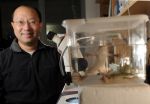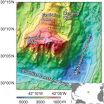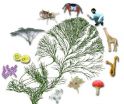(Press-News.org) Boston, Mass. – Although people infected with HIV produce many antibodies against the protein encapsulating the virus, most of these antibodies are strangely ineffective at fighting the disease. A new study suggests why some of the most common of these antibodies don't work: they target the protein in a form it takes after the virus has already invaded the cell, when it's too late, report researchers at Children's Hospital Boston and their colleagues.
The findings, published online Nov. 14 in the journal Nature Structural & Molecular Biology, refocus attention on the rare group of neutralizing antibodies that do work, described by the team in an earlier study. These antibodies home in on the protein at an earlier moment when the virus latches onto a healthy cell. Many people believe an effective HIV vaccine will need to greatly expand this rare antibody immune response to block infection. Children's has filed for patents on two new proteins designed to expand this rare antibody response.
"The key finding of this paper is that we can distinguish the shape of the protein targeted by useful antibodies," said senior author Bing Chen, PhD, of the Department of Molecular Medicine at Children's. "That means we can think about designing immunogens trapped in this defined structure and ways to prevent the protein from forming into an irrelevant conformation."
The same HIV protein, known as gp41, takes two such dramatically different configurations that it reacts with two different kinds of antibodies, Chen's group shows. In HIV, the protein travels under wraps on the surface of virus particles. When the virus locks onto a healthy cell, the protein briefly unfolds and stretches out to its full length, extending out like a person reaching high overhead. This is the shape that generates rare but useful neutralizing antibodies in some people.
Then comes another shape change. After taking hold of the cell membrane, the protein folds over, like a person touching his toes, to fuse the cell to the virus membrane. That final calisthenic to fuse the membranes also creates an opening that allows the viral contents to invade the cell. At this stage, the protein functions as a decoy, serving only to bring on fruitless antibody responses and to distract the immune system, the authors wrote in the paper.
"We now believe that the neutralizing antibodies bind to the intermediate state, which prevents further structural rearrangements and blocks membrane fusion," said Chen, who is also affiliated with Harvard Medical School. "The key is that we can now separate which antibody recognizes which state, so that we can move forward to design an immunogen to induce an effective antibody response."
The findings suggest a new way of generating more useful anti-HIV antibodies. The intermediate stage of the protein normally lasts only about 15 minutes, too quickly to mount a successful immune response. For earlier work, the team leveraged the power of the first fusion-inhibiting antiviral drug, T20 (enfuviritide), approved for late-stage disease when other treatment options are failing. The drug traps the protein in the shape that spurs useful antibodies, the researchers reported in an earlier paper. In the latest study, the team further refined the protein for this study in a variation that does not require the drug. Additional biochemical experiments confirmed that two rare neutralizing antibodies from patients tackled the fleeting intermediate state of the experimental protein.
"This paper helps to resolve key questions plaguing the field: Why do certain forms of the protein interact with certain antibodies, and why aren't these antibodies in general more effective?" said virologist Dan Barouch, professor of medicine at Harvard Medical School and Beth Israel Deaconess Medical Center, who was not involved in the study. "This paper shows how particular antibodies react with different conformation states of gp41, but the implications are well beyond that. The results also offer a new way of thinking about envelope immunogen design." Barouch is collaborating with Chen to test the immunogenicity of the protein in animal models.
Chen's team discovered the immune-evasion power of the decoy protein shape in studies led by Gary Frey, PhD, and Jia Chen, PhD. Frey and Chen solved the atomic structure of a useless antibody bond to the final form of the protein. "The postfusion state is very stable," said Chen, allowing plenty of time for the body to churn out worthless antibodies.
A companion paper from a Duke University group published simultaneously online shows another non-neutralizing antibody binding to a slightly different region of the protein in the postfusion form, further confirming the findings reported by Chen's group.
INFORMATION:
Funding: US National Institutes of Health; a Collaboration for AIDS Vaccine Discovery grant from the Bill and Melinda Gates Foundation; the Center for HIV/AIDS Vaccine Immunology; the Department of Veterans Affairs; and the Ragon Institute of MGH, MIT and Harvard.
Children's Hospital Boston is home to the world's largest research enterprise based at a pediatric medical center, where its discoveries have benefited both children and adults since 1869. More than 1,100 scientists, including nine members of the National Academy of Sciences, 12 members of the Institute of Medicine and 13 members of the Howard Hughes Medical Institute comprise Children's research community. Founded as a 20-bed hospital for children, Children's Hospital Boston today is a 392-bed comprehensive center for pediatric and adolescent health care grounded in the values of excellence in patient care and sensitivity to the complex needs and diversity of children and families. Children's also is the primary pediatric teaching affiliate of Harvard Medical School. For more information about the hospital and its research visit: www.childrenshospital.org/newsroom.
Designing more effective anti-HIV antibodies
Trapping a shape change during the infection process could lead to new vaccine strategies
2010-11-20
ELSE PRESS RELEASES FROM THIS DATE:
Professor Zvi Ram presents phase III recurrent glioblastoma survival and quality of life data from the first pivotal study of the NovoTTF-100A at 15th Annual Society for Neuro-Oncology Scientific Meet
2010-11-20
MONTREAL, CANADA - November 19, 2010 - Data presented today from a pivotal, phase III randomized clinical trial for patients with recurrent glioblastoma tumors suggest that Tumor Treating Fields (TTF) therapy may increase median survival time and improve quality of life scores compared to best standard of care chemotherapy. Professor Zvi Ram, chairman of the Department of Neurosurgery at Tel-Aviv Sourasky Medical Center, presented the data at the Society for Neuro-Oncology (SNO) Annual Scientific Meeting.
Physicians delivered the investigational TTF therapy to patients ...
Childhood obesity linked to increased risk of adult cardiovascular and metabolic disorders
2010-11-20
New Rochelle, NY, November 19, 2010—Mounting evidence linking childhood obesity to an increasing risk of obesity, heart disease, type 2 diabetes, and other cardiovascular and metabolic disorders in adulthood is clearly presented in a comprehensive review article in the current issue of Childhood Obesity, published by Mary Ann Liebert, Inc. The article is available free online.
Authors Megan Moriarty-Kelsey, MD and Stephen Daniels, MD, PhD, Department of Pediatrics, University of Colorado School of Medicine, caution that the rising prevalence of obesity in children will ...
New path for colon cancer drug discovery
2010-11-20
An old pinworm medicine is a new lead in the search for compounds that block a signaling pathway implicated in colon cancer. The findings, reported by Vanderbilt University Medical Center researchers in the November issue of Nature Chemical Biology, suggest a fresh approach for developing therapeutics that target the pathway.
More than 90 percent of sporadic (non-inherited) colon cancers – the second deadliest type of cancer in the developed world – are caused by mutations that result in inappropriate activation of the Wnt (pronounced "wint") signaling pathway. Blocking ...
Scripps Research scientists identify first synthetic activator of 2 critical proteins
2010-11-20
JUPITER, FL, November 19, 2010 – Scientists from the Florida campus of The Scripps Research Institute have identified a novel synthetic activator of a pair of proteins that belong to a protein family playing key roles in human metabolism and immune function. The discovery could provide new and potentially more effective therapeutic approaches to diseases ranging from diabetes to osteoporosis.
The study was published in the November issue (Volume 5, Issue 11) of the journal ACS Chemical Biology.
"This new compound is particularly important because it works in vivo, ...
Invention helps students learn surgical techniques before operating on patients
2010-11-20
FORT COLLINS - In the last 50 years, modern medicine has made astounding advances in surgery, yet many of today's veterinary and human medicine students still hone basic surgical and suturing skills on carpet pads and pig's feet before transitioning to a live patient. An invention by Colorado State University veterinarians provides students with artificial body parts that look, feel, behave, and even bleed just like real skin, muscles and vessels.
The artificial replicas of sections of human and animal bodies -- such as an abdominal wall -- give students a realistic learning ...
UH physicists study behavior of enzyme linked to Alzheimer's, cancer
2010-11-20
HOUSTON, Nov. 19, 2010 – University of Houston (UH) physicists are using complex computer simulations to illuminate the workings of a crucial protein that, when malfunctioning, may cause Alzheimer's and cancer.
Margaret Cheung, assistant professor of physics at UH, and Antonios Samiotakis, a physics Ph.D. student, described their findings in a paper titled "Structure, function, and folding of phosphoglycerate kinase (PGK) are strongly perturbed by macromolecular crowding," published in a recent issue of the journal Proceedings of the National Academy of Sciences, one ...
New study into bladder regeneration heralds organ replacement treatment
2010-11-20
Researchers in the United States have developed a medical model for regenerating bladders using stem cells harvested from a patient's own bone marrow. The research, published in STEM CELLS, is especially relevant for paediatric patients suffering from abnormally developed bladders, but also represents another step towards new organ replacement therapies.
The research, led by Dr Arun Sharma and Earl Cheng from the Feinberg School of Medicine at Northwestern University and Children's Memorial Research Center, focused on bone marrow mesenchymal stem cells (MSCs) taken from ...
Busy microbial world discovered in deepest ocean crust ever explored
2010-11-20
CORVALLIS, Ore. – The first study to ever explore biological activity in the deepest layer of ocean crust has found bacteria with a remarkable range of capabilities, including eating hydrocarbons and natural gas, and "fixing" or storing carbon.
The research, just published in the journal PLoS One, showed that a significant number and amount of bacterial forms were present, even in temperatures near the boiling point of water.
"This is a new ecosystem that almost no one has ever explored," said Martin Fisk, a professor in the College of Oceanic and Atmospheric Sciences ...
AgriLife scientist: Functional amino acids regulate key metabolic pathways
2010-11-20
COLLEGE STATION - Functional amino acids play a critical role in the development of both animals and humans, according to a Texas AgriLife Research scientist.
In a journal article appearing in the American Society for Nutrition (Advances in Nutrition 1:31-37, 2010), Dr. Guoyao Wu, AgriLife Research animal nutritionist and senior faculty fellow in the department of animal science at Texas A&M University, calls for scientists to "think out of the box" and place more emphasis on this area of study.
"We need to move forward and capitalize on the potential of functional ...
Reading the signs: Plants and animals found common ground in response to microbial threats
2010-11-20
Though it's been at least a billion years since plants and animals shared a common ancestor, they have through the eons shared a common threat in the form of microbes, including bacteria, eukaryotes and viruses. This has resulted in remarkably similar mechanisms for detecting the molecular signatures of infectious organisms that hold promise for the future treatment of infectious diseases in humans.
The recognition of microbial signature molecules by host receptors is the subject of a paper published in the journal Science titled "Plant and Animal Sensors of Conserved ...
LAST 30 PRESS RELEASES:
House sparrows in northern Norway can help us save other endangered animals
Crohn's & Colitis Foundation survey reveals more than 1/3 of young adults with IBD face step therapy insurance barriers
Tethered UAV autonomous knotting on environmental structures for transport
Decentralized social media platforms unlock authentic consumer feedback
American Pediatric Society announces Vanderbilt University School of Medicine as host institution for APS Howland Visiting Professor Program
Scientists discover first method to safely back up quantum information
A role for orange pigments in birds and human redheads
Pathways to net-zero greenhouse gas emissions for Southeast Asia
A JBNU–KIMS collaborative study on a cost-effective alloy matches superalloys for power plants and energy infrastructure
New study overturns long-held model of how plants coordinate immune responses.
New AI model predicts disease risk while you sleep
Scientists discover molecular ‘reshuffle’ and crack an 80-year-old conundrum
How stressors during pregnancy impact the developing fetal brain
Electrons lag behind the nucleus
From fungi to brain cells: one scientist's winding path reveals how epigenomics shapes neural destiny
Schizophrenia and osteoporosis share 195 genetic loci, highlighting unexpected biological bridges between brain and bone
Schizophrenia-linked genetic variant renders key brain receptor completely unresponsive to both natural and therapeutic compounds
Innovative review reveals overlooked complexity in cellular energy sensor's dual roles in Alzheimer's disease
Autism research reframed: Why heterogeneity is the data, not the noise
Brazil's genetic treasure trove: supercentenarians reveal secrets of extreme human longevity
The (metabolic) cost of life
CFRI special issue call for papers: New Frontiers in Sustainable Finance
HKU Engineering scholar demonstrates the smallest all-printed infrared photodetectors to date
Precision empowerment for brain "eavesdropping": CAS team develops triple-electrode integrated functional electrode for simultaneous monitoring of neural signals and chemical transmitters during sleep
Single-capillary endothelial dysfunction resolved by optoacoustic mesoscopy
HKU three research projects named among ‘Top 10 Innovation & Technology News in Hong Kong 2025’ showcasing excellence in research and technology transfer
NLRSeek: A reannotation-based pipeline for mining missing NLR genes in sequenced genomes
A strand and whole genome duplication–aware collinear gene identification tool
Light storage in light cages: A revolutionary approach to on-chip quantum memories
Point spread function decoupling in computational fluorescence microscopy
[Press-News.org] Designing more effective anti-HIV antibodiesTrapping a shape change during the infection process could lead to new vaccine strategies



